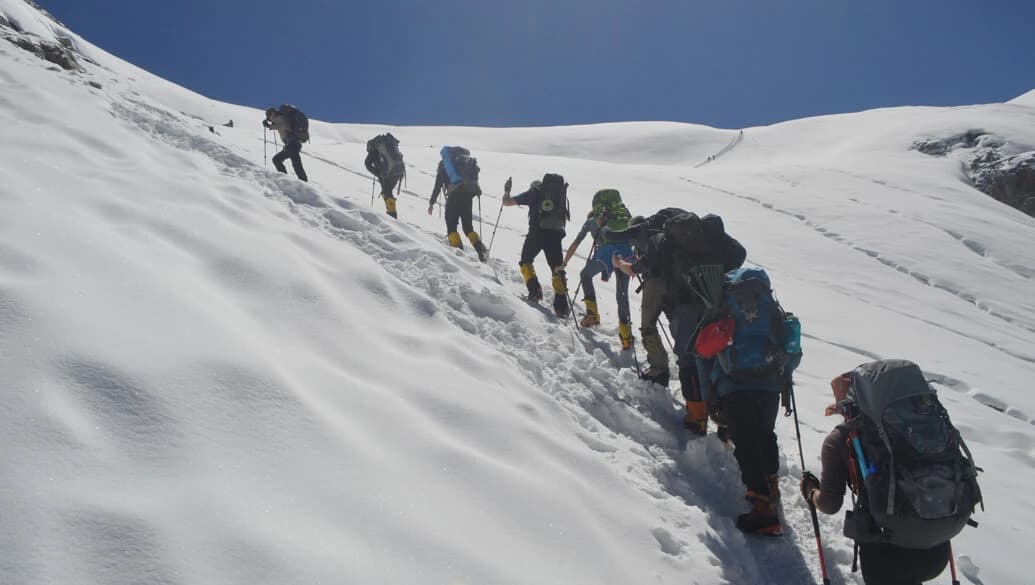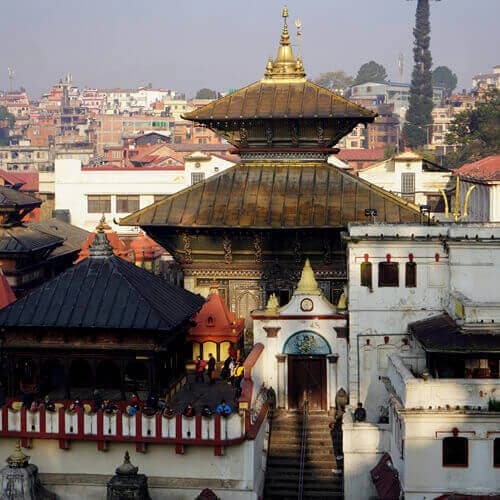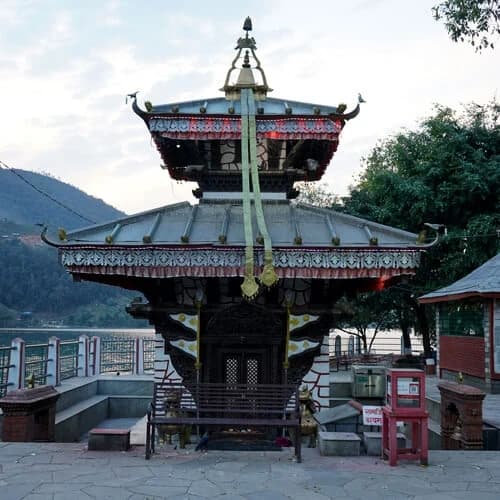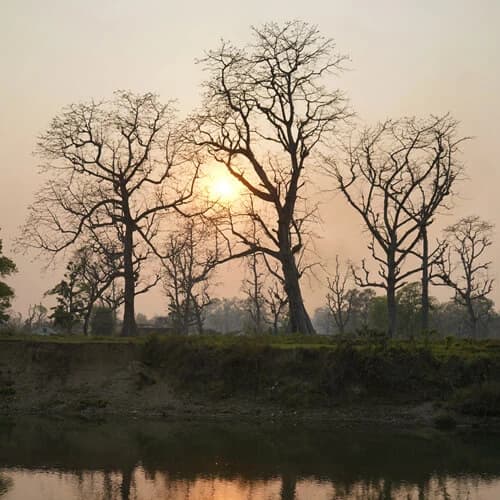Highlights of the Mera Peak Expedition 12 Days
- A scenic and thrilling flight to Tenzing Hillary Airport, Lukla.
- Remarkable views of Mount Everest, Makalu, Lhotse, Kanchenjunga, Cho-Oyu, and other peaks.
- Summit is the highest trekking peak in Nepal.
- Hike through remote and diverse landscapes of the Khumbu/Everest region.
- Overnight stay at Mera Peak Base Camp with breathtaking views.
- Majestic sunrise and sunset view as you ascend to higher altitudes.
- Experience the hospitality and unique culture of Sherpas, the indigenous mountain people.
- It is a thrilling and adventurous climb and glacial crossing.
Summiting Mera Peak Expedition
Mera Peak expedition is not a technically demanding ascent and can be achieved by participants with basic mountaineering skills. On the summit day, the ascent to the peak is long and exhausting, exposing you to several elements of the high mountains. Before you begin the climb, you need to hydrate yourself and maintain a healthy diet. This ensures your body is replenished for the final push of this remarkable journey. The route to the summit involves a slow and gradual trek on snowy terrain and several glacier crossings. During the ascent, you will climb using a man rope, maintaining a gradual pace with other participants.
Mera Peak Climbing is relatively steep and requires crampons and an ice axe to navigate further. Finally, you will have to make your way up on a snow wall at a 50-degree angle with the help of ascenders and fixed ropes. Completing the summit is a rewarding experience that will give travelers memories that will last a lifetime. You will have glorious views of Everest, Kanchenjunga, Makalu, Lhotse, Nuptse, Kang Taiga, and Ama Dablam from the top of the peak. After our brief celebration, we will retrace the route back to Khare.
It has three summits, including Mera South (6,065 m), Mera North (6,467 m), and Mera Central (6,461 m). In our short 12 Days Short Mera Peak package, we will ascend Mera Peak Central. In recent years, this alpine tour package has become a popular option among mountaineers. Mera Peak has become renowned as a practice peak for beginners to enhance their skills and add to their experience. This swift and well-organized expedition is an excellent choice for novice mountaineers who want to prepare for future adventures in higher peaks.
The challenging yet rewarding journey offers travelers glorious views of Makalu, Kangchenjunga, and Everest, among other mountain peaks. The brief 12 Days Mera Peak expedition is recommended for travelers who want to participate in an insightful mountaineering expedition quickly.
Quick Facts about Short Mera Peak Climbing
- Marcel Jolly, G. Baus, and L. Honills first submitted Mera Peak Central in 1975.
- It is also widely claimed that L. Limarques, Ang Lhakpa, and two other Sherpas made the first ascent to Mera Peak on 29 October 1973.
- Hari Budha Magar was the double-knee amputee who climbed Mera Peak.
- The climb to the summit starts at 2 a.m. from high camp, with an elevation gain of 661m, and takes 4-5 hours to complete.
- The oxygen level at the summit is around 47% to 43% as compared to the sea level.
How difficult is the ascent to Mera Peak?
The Mera Peak Expedition falls in the PD (Peu Difficile) category according to the International French Adjectival System (IFAS) classification. It is regarded to be a moderately difficult climb. Some factors that make this Himalaya tour challenging are high altitude, unpredictable weather, experience, lack of proper facilities along the trail, etc. The expedition also requires basic mountaineering skills.
This includes using ice, axes, crampons, climbing ropes during navigation in ice slopes, and crevassed glaciers. Nonetheless, with proper training and guidance from experts, the journey is unparalleled in the Himalayas of Nepal. The reward of conquering the Mera Peak summit is unparalleled, standing at the top of these mountains brings a sense of achievement and inspiring panoramic views. So, embrace the challenges, overcome the obstacles, and allow your spirit of adventure to lead you to new heights.
Is this Mountaineering Expedition Suitable for You?
The 12 Days Mera Peak Expedition is a quick journey suitable for travelers with basic mountaineering skills. Although the climb does not require previous climbing experience, participants must be familiar with crampons, climbing ropes, ascenders, and ice axes. Having said that, we only recommend this Himalayan adventure to travelers with previous high-altitude trekking experiences.
Participants with prior knowledge of the trek are more likely to tackle the challenges along the trail and adapt smoothly to the elevation gain. Any individuals who have completed previous tours in the Himalayas can find them suitable for the Short Mera Peak Expedition. Keep in mind that before attempting the summit, you will be provided with introductory training on mountaineering. All of our participants will have a session with a climbing guide to learn the basic skills essential for the final push.
Fitness Level Required for Mera Peak
To attempt the summit of Mera Peak, you must be in a moderate level of physical fitness. A traveler must carry a bag pack weighing around 5-8 kgs while they trek on rugged terrains. This can be physically demanding and exhausting for beginners. Please prepare and train yourself for over 4 to 6 months before the trip. As the expedition takes over 6,000m, you must be healthy to overcome the potential physical challenges.
It is also essential to remember that climbing this grade requires exceptional cardiovascular fitness. So, to prepare you, we will help build an appropriate training program to enhance your stamina, cardio, and strength. If you have any shortfalls during the evaluation, we will develop a support plan that includes high-altitude trekking and sports climbing to improve your experience. These steps will not only ensure your safety and well-being but also ensure that you achieve your objectives.
How You Should Prepare for the Short Mera Peak Expedition
Travelers must be physically fit and have good endurance to successfully summit Mera Peak. Depending on your physical condition, we highly recommend beginning a fitness program 3 to 6 months before the trip. The workout routine must focus on building stamina, strength, and core muscles. Participants can achieve their personal goals by following the introductory training regime listed below.
- Physical Endurance: Jogging, hiking, weightlifting, swimming, skipping, squatting, and pull-ups can enhance your stamina and overall strength.
- Learn basic climbing: Study mountaineering courses and guides to learn how to use climbing equipment. This will help boost your confidence and morale as well.
- Maintain a healthy diet: You must stay energetic for your workout routine and the expedition. So, it is essential to consume foods and beverages high in healthy carbohydrates, proteins, minerals, nutrients, and electrolytes.
- Practice mindfulness: The 12 Days Mera Peak Expedition is mentally exhausting, so you must be able to calm yourself while dealing with difficulties. You also need to cooperate and support climbing participants and adjust to the changing weather conditions.
Mera Peak Expedition Cost for 2026, 2027
12 days Mera Peak Expedition Cost is 2250 USD for a single person. The price of the package depends on several factors, including services added, itinerary, group size, and other personal preferences. Our operators meticulously design and curate the trip to ensure an exceptional travel experience for our clients.




